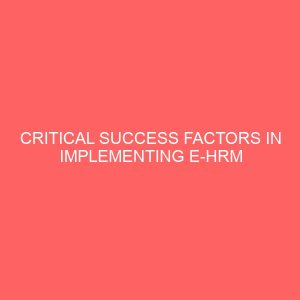Description
INTRODUCTION
BACKGROUND OF THE STUDY
In a sprouting Nigerian banking industry, strategies are being adopted by the major players so as to accomplish their long haul hierarchical objectives productivity and survival.
Since the early 1980s there has been a shift towards more information technology(IT) focused business processes. First bankof Nigeria seek to mechanizetheir practices and processes with the use of IT while looking for cost savingsand to improve efficiency by streamlining processes and practices. Certainly, inrecent years advanced IT systems have become fundamentals for First Bank most especially Lagos branch and theyare spending ever more in them accordingly. Nevertheless,in reality the business world does not seem to be more streamlined and simple; itseems to be becoming more difficult and complex; or perhaps we are being forcedto recognize its complexity (Lane et al. 2004).Serious factors in Implementing Strategic Human Resource Management in OrganizationalSuccess” have gone through the influence of implementing Electronic human resource management on theorganizational success and how implementing such strategies may have the influence to set the organization to ahigher level of success bearing in mind the process of bringing the vision and mission of the organization toreality.
Conversely, the ongoing development that have reigned the world during the last few decades specificallytechnology wise managed to throw its influence on every aspect of life majorly taking into account theimportance of the human element in managing and administrating these developments in a way that guaranteesthe best and most efficient operating of modern technologies.
First Bankis well thought-out to be one of the first and most importance bankingestablishment in the Nigeria.
The Bank First Bank of Nigeria Plc was instituted by Sir Alfred Jones, a distribution magnate, in 1894. First Bank of NigeriaPlc has provided exceptional banking services and therefore, contributed to the economic encroachment and development ofNigeria for over 113 years. Consolidated as a restricted risk organization with its head office initially in Liverpool, FirstBank initiated business on a humble scale in the premises of Elder Dempster and Company Limited in Lagos underthe name Bank of British West Africa (BBWA) with paid-up capital of £12,000.00 (Twelve Thousand Pounds). This was in the wake of retaining its antecedent, the African Banking Corporation, which was established in 1892, the Bank additionally obtained its first rival, the Bank of Nigeria (previously called Anglo-African Bank) which was founded in 1899 by the RoyalNiger Company.
Comparatively, both strategic human resource management and electronic human resource management (e-HRM) are somewhat new research streams. Strategic HRM writing surfaced about 30 years ago and early e-HRM studies begin appearing around 1995. Fascinatingly, both research streams bring into play potentially transformational outcomes for the role of human resource management within organizations. In the strategic HRM literature, scholars center on strategic outcomes such as organizational performance, strategic alignment, and ready for action advantage. In the e-HRM literature, researchers look forward to internet-based technological innovations to aid in realizing the outcomes predicted in the strategic HRM literature. Organizational goals for e-HRM investments consist of cost reduction through streamlining HRM operationsimproved efficacy through providing better delivery of HRM services and transformation of the HRM function to a strategic business cohort.
The most important concept that underlies the practice of human resources managementis that human beings are the most important and crucial resource and asset for anorganization’s enlargement and development. Also, organisations must be able to decide the keyrole of human resources (HR) and bring in or strengthen the suitable HR skillsand capabilities in order to make HR convincing and a real business partner.
Electronic human resource management practices as a factor of organizational performance has gain currency in the last two decades in the banking industryespecially the rapid growth of the First Bank, Nigeria. On the other hand, the outcomes from the researchers are either inconclusive or controversial (Qureshi et al., 2007).
The knowledge-intensifying process of the economy and the correlated rise of organizational networks, withtheir more noteworthy reliance on qualified and submitted representatives, recognize the requirement for a type of HRM that takes care of the requests and needs of the administration and the workers. As a result in today’s IT based economy the need forEHRMsystem has become imperative to meet the HR challenges of 21stcentury (Zafar, 2010).For this reason,First bank, Lagos branch have increasingly been introducing web-based applications for HRM purposes, and these arefrequently labeled as E-HRM system (Swaroop, 2012).The express development of the Internet during the lastdecade has also boosted the implementation and application of electronic Human Resource Management. Surveysof HR consultants notice that both the number of organizations adopting E-HRM and the depth of applicationswithin the organizations are continually increasing.
In addition, today the world is becoming moremultifaceted, dynamic and increasingly uncertain. Globalization archetype, a procedure cultivated and impelled by quick changes in the information and communication technology, is making the world economy more interdependent.
Globalization pattern is an important factor that influences organizations that compete for customers with highexpectations in performance, quality, & low cost (Friedman, 2007).
Consequently one of the originalcharacteristics of the globalization paradigm is implementing and promoting the E-HRM system. In other words,E-HRM can be well thought-out as the main element in capacitating the globalization paradigm. Developing andmanaging E-HRM system globally, leads to the development of the office workers who are able to think, beguided and operate globally. Those who possess such universal skills may have a global mentality in the context ofweb networks (Hamidi&Sarfarazi, 2010). Hence in order to implement and develop the E-HRM system globally,particularly in developing countries like Nigeria, first there is a need for expert, interested and professional managers in thefield of web and meanwhile significant ideological changes concerning the role of the E-HRM system shouldhappen to know how to apply this system’s tools regionally, nationally and internationally to take basic steps incapacitating globalization paradigm.
Technology develops quickly and keeping pace with the developments and demandsfor organizational structures is challenging. Being a winner in the new,more complex economy requires First bank to deploy the right mix of information,people, and IT capabilities.
This kind of mix is concerned withusing information and knowledge effectively, and necessitates an appropriate enablingof IT services and infrastructure. Understanding how people use informationand knowledge is essential for First bank and key to their strategy development.
Observable, First bank requires its managers to establishan ‘information orientated’ view of the industry in which First bank is competing,based on how their employees use information and IT to achieve business results.This is a key strategic priority. Besides, achieving the right balance betweenbusiness flexibility and standardization cannot be achieved without a correspondingtransformation of how IT, and especially that part addressing HRM, is deployedacross the bank. However, first bank had successfully implemented and utilizesE-HRM approach as the web-based technologies to provide HRM services within the sector. First E-HRM embraces e-recruitment and e-learning, the first fields of human resource management to make extensive use of web-based technology. From this base e-HRM has expanded to embrace the delivery of virtually all HR policies. Within a system of e-HRM, it is possible for first bank managers to use desktop computers to arrange and conduct appraisals, plan training and development, evaluate labour costs, and examine indicators for turnover and absenteeism. Employees can also use a system of e-HRM to plan their personal development, apply for promotion and new jobs, and access a range of information on HR policy. Systems of e-HRM are increasingly supported by dedicated software produced by private suppliers. First bank has successfully adopt E-HRM method since itis the (planning, implementation and) application of information technology for both networking and supporting at least two individual or collective actors in their shared performing of HR activities(Strohmeier 2007: 20).
Furthermore, E-HRM is in essence the decentralization of HR functions to management and employees. They access these functions typically via intranet or other web-technology channels. The empowerment of managers and employees to perform certain chosen HR functions relieves the HR department of these tasks, allowing HR staff to focus less on the operational and more on the strategic elements of HR, and allowing organisations to lower HR department staffing levels as the administrative burden is lightened.
It is expected that, as E-HRM develops and becomes more entrenched in business culture, these changes will become more apparent, but they have yet to be manifested to a significant degree. A 2007 CIPD survey states that “The initial research indicates that much-commented-on development such as shared services; outsourcing and e-HR have had relatively little impact on costs or staff numbers”.
The greater than ever use of technology is a result of HR departments in First bank facinggreater efficiency and cost-effectiveness pressures than ever before. In response tothese pressures, the main motivation to adopt e-HRM systems is based on the‘transformation of HR’, which means that e-HRM may improve efficiency, cutcosts and ultimately facilitate a shift in the HR role to a more strategic level (Parry& Tyson 2011). In other words, e-HRM, in theory, enables the HR departmentsof first bank to analyze and store data to increase the flow of workforce informationas well as enabling the devolution of many routine administrative and compliancefunctions traditionally performed by corporate HR departments (Bondarouk et al.
2009; Tansley 2001). Therefore, e-HRM systems in general have the potential toenhance the contribution HR makes to the company’s strategic aims (Kavanagh etal. 2012).Though, IT issues in HRM research are not well-structured (Hoobler&Johnson 2004), and the e-HRM research field is still in its infancy and is supportedby only limited empirical evidence.
Statement of the problem
At the point when administration collaboration are not legitimately controlled and took care of, or not even handled at all, the outcome is poor perception or service quality and customer dissatisfaction, Hence the need for properly managed E-HRM frame.
The banking sector improvement in Nigeria, particularly the recapitalization policy initiative has absolutely posed someproblems and challenges to both the banking system and economy. One major of the issues arising from the reform thatrequire attention is the human resources management in the consolidated banks. This research considers the factors that geared towards the adoption of Electronic human resources management (E-HRM) framework and provides empirical evidence from Nigeria. There is the need for study on the E-HRM impact on banks performance in the post consolidationera in Nigeria. The study tries to identify whether certain innovative E-HRM practices have stronger significant effect thanothers and the significance of the identified Electronic human resources practices implemented in First bank of Nigeria
Objectives of the Study
By depiction from the various scientific disciplines such as HRM, IS and FutureStudies, the aim of this study is to contribute to the existinge-HRM literature in an international context. In synopsis, this study extends the theoretical foundations from the fields of HRM and IS to the e-HRMfield, and the study concludes by merging these theories with a discussionof what constitutes truly global e-HRM.
The specific objectives of the study are to:
To determine the importance of E-HRM in Lagos State First bank.
To examine the impact of human resources management on employee through the use of ICT.
To study the role play by human resource management in the implementation of E-HRM.
To investigate the impact of E-HRM on Staff in first bank of Nigeria.
To make suggestion on Human resources management patterns with the view of improving employee’s performance.
Significance of the Study
The saying that people are the most significant asset has been a recurringtheme in many firms and organisations, which is also true to First bank.A First bank’s effectiveness seriously depends on its trustworthiness. Trustworthinessrefers to a first bank’s capacity to keep track of, and carefully analyse, themany factors that affect its core business, namely to maintain price and financialstability. It also necessitates the ability to respond with sound and well-thought outpolicies as and when the need arises. This, in turn, principally depends on the qualityof the staff, such as essential skills, expertise, and, experience and sound judgment.
Thus, managing human resources effectively is a critical element in maintainingan effective and credible first bank.To the participating first banks, this study would enable them to reviewtheir current E-HRM practices and policies based on the best HRM practices andpolicies of other banks and organisations; and reinforce their commitmentto manage their human resources effectively as a critical element in maintainingan effective and credible first bank.
In general there are four necessary requirements to be considered in the E-HRM; first the
units of human resources are asked to focus on the strategic questions; second these units need to be flexible in policy making and practical actions. And third the units of human resources should work effectively and be aware of the costs. Four, the units of human resources should be at the service of managers and workers. In short, these units must focus on the strategy, flexibility and be efficient and customer-oriented simultaneously (Kaur, 2013).
Research question
In order to tackle existing research gaps and meet its own objectives, this studyaims to answer the following research questions:
1) What factors influence the acceptance and use of e-HRM in First bank subsidiaries?
2) How do these factors influence e-HRM’s strategic potential and other outcomes?
3) What are the likely future trends in ICT and what implications will thesetrends have for HRM and e-HRM?
STATEMENT OF HYPOTHESIS
Is there a relationship between EHRM and efficient service delivery in the bank?
Is there a significant relationship between ICT and Human Resource Management resulting to EHRM?
Is there any positive relationship between successful implementation of EHRM and effective performance in Lagos state First bank of Nigeria?
Limitations
The limitations for this study are as follows:
Limited time available on the part of the researcher to carry out an extensive investigation and high cost of acquiring needed material
The results are restricted by the instrument used.
The results are self-reported in nature and some variables are based on respondent opinions.
The respondents may not have had enough knowledge to respond accurately.
The results are limited to the population of first banks in Lagos State of Nigeria. The results cannot be generalized to other first banks outside the specified state and nations.
Scope of the study
The critical success factors employ in implementing EHRM practices in first bank on the performance ofthe firm as a study of selected first banksin Lagos State wasthe influence of this study with a major focus only onfirst bank. Other areas focus by the study were critical examination of the successful factors used in influencing positive implementation of EHRM practices as a strategy to facilitate first bank growth and workers performancein the banking sector.







